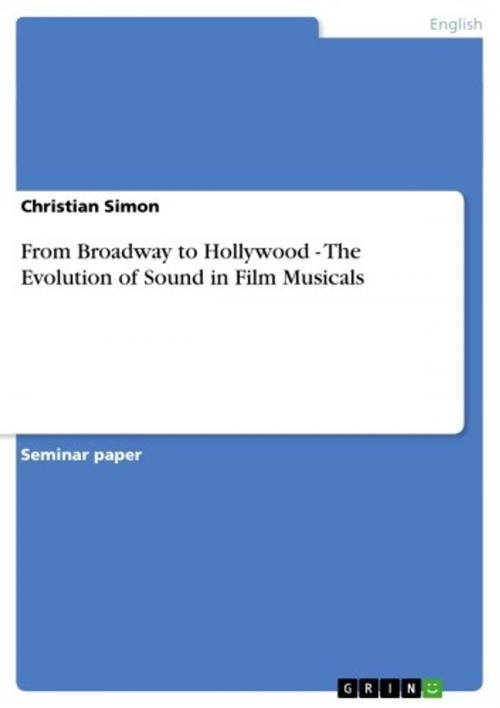From Broadway to Hollywood - The Evolution of Sound in Film Musicals
The Evolution of Sound in Film Musicals
Nonfiction, Entertainment, Drama, Anthologies| Author: | Christian Simon | ISBN: | 9783638315920 |
| Publisher: | GRIN Publishing | Publication: | October 16, 2004 |
| Imprint: | GRIN Publishing | Language: | English |
| Author: | Christian Simon |
| ISBN: | 9783638315920 |
| Publisher: | GRIN Publishing |
| Publication: | October 16, 2004 |
| Imprint: | GRIN Publishing |
| Language: | English |
Seminar paper from the year 2004 in the subject American Studies - Culture and Applied Geography, grade: 1,7 (A-), LMU Munich, 20 entries in the bibliography, language: English, abstract: 'Everybody comes to Hollywood; they wanna make it in the neighborhood. They like the smell of it in Hollywood (...)', lines of a famous Madonna song from last year. Hollywood, the purpose-built dream factory at the West Coast of the United States and the filmic center of the world produces countless films and movies every year. The unprecedented success story of the Californian film industry is a summary of work, imagination, hopes, and dreams of many talented and gifted human beings. The HOLLYWOOD sign atop of Mount Lee was erected in 1923. Originally, it read HOLLYWOODLAND and intended to draw attention to new housing developments in the nearby Hollywood Hills. Nowadays, the sign symbols the world's gateway for fantasies and dreams. In the United States, the film industry started to emerge in New York City and was later joined by steadily growing and stronger forces in California. Over time, the center of the industry moved across the country and set foot in Los Angeles. Films started out with static, silent pictures and without sound. In 1928, sound was added to movies for the very first time, in that way giving birth to the film musical. Film musicals further encouraged fantasies and became one of the industry's largest and most successful genres at the beginning of a new era. In the following paragraphs, I want to explain the formation of the talkies by means of one of its most successful divisions - the film musical. Altogether, when things happened, where, why, and in which order is not clearly recognizable any more. For these causes, I want to develop a strongly intertwined scheme of a cycle of histories as well as analyzing sociological, political, technological, ideological and other relevant factors of the time to describe the evolution and outstanding success of the Hollywood musical. First, technical advancements at the beginning of the last century and the birth of Hollywood have to be given a close look to examine the entertainment industry which grew rapidly around and after the turn from the 19th to the 20th century. The reason for this shift towards more time for leisure activities went hand in hand with the fewer hours workers had to spend for their duties, tasks and responsibilities. Originally intended to save labor capacity, industrial innovations like the assembly line and other new, time-saving technologies passed their ways through in the employment market. [...]
Seminar paper from the year 2004 in the subject American Studies - Culture and Applied Geography, grade: 1,7 (A-), LMU Munich, 20 entries in the bibliography, language: English, abstract: 'Everybody comes to Hollywood; they wanna make it in the neighborhood. They like the smell of it in Hollywood (...)', lines of a famous Madonna song from last year. Hollywood, the purpose-built dream factory at the West Coast of the United States and the filmic center of the world produces countless films and movies every year. The unprecedented success story of the Californian film industry is a summary of work, imagination, hopes, and dreams of many talented and gifted human beings. The HOLLYWOOD sign atop of Mount Lee was erected in 1923. Originally, it read HOLLYWOODLAND and intended to draw attention to new housing developments in the nearby Hollywood Hills. Nowadays, the sign symbols the world's gateway for fantasies and dreams. In the United States, the film industry started to emerge in New York City and was later joined by steadily growing and stronger forces in California. Over time, the center of the industry moved across the country and set foot in Los Angeles. Films started out with static, silent pictures and without sound. In 1928, sound was added to movies for the very first time, in that way giving birth to the film musical. Film musicals further encouraged fantasies and became one of the industry's largest and most successful genres at the beginning of a new era. In the following paragraphs, I want to explain the formation of the talkies by means of one of its most successful divisions - the film musical. Altogether, when things happened, where, why, and in which order is not clearly recognizable any more. For these causes, I want to develop a strongly intertwined scheme of a cycle of histories as well as analyzing sociological, political, technological, ideological and other relevant factors of the time to describe the evolution and outstanding success of the Hollywood musical. First, technical advancements at the beginning of the last century and the birth of Hollywood have to be given a close look to examine the entertainment industry which grew rapidly around and after the turn from the 19th to the 20th century. The reason for this shift towards more time for leisure activities went hand in hand with the fewer hours workers had to spend for their duties, tasks and responsibilities. Originally intended to save labor capacity, industrial innovations like the assembly line and other new, time-saving technologies passed their ways through in the employment market. [...]















